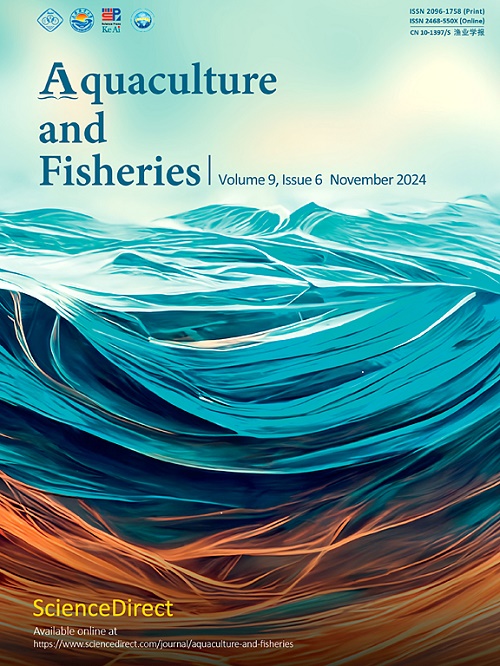基于形态学的克氏原鲤腹肉产量选育策略分析
Q1 Agricultural and Biological Sciences
引用次数: 0
摘要
克氏原螯虾的可食用部分主要由腹部肌肉组成,在育种中突出了腹部肉产量的遗传增强。为探索克拉氏弧菌腹肉产量的选择性育种策略,对中国主要产区克拉氏弧菌5个种群的形态特征与腹肉产量的相关性进行了分析,构建了预测克拉氏弧菌腹肉产量的最优预测模型。通过对clarkii病原菌形态特征的分析,最终选择富尔顿条件因子(Fulton’s condition factor, K)作为形态预测因子,该因子与腹肉产量呈显著负相关(雄性为-0.800,雌性为- 0.705),且不需要牺牲候选育种品种。基于K值构建的最优预测模型为二次曲线,男性R2值为0.684,女性R2值为0.590,男性和女性实测值与预测值的相关系数分别为0.827和0.768。利用最优预测模型进行的腹肉产量选择育种实验结果表明,繁殖群体的形态变异符合预期。这些发现为克拉氏杆菌腹肉产量的育种提供了一种基于形态的选择策略。本文章由计算机程序翻译,如有差异,请以英文原文为准。
Morphology-based selective breeding strategy analysis for abdominal meat yield in Procambarus clarkii
The edible portion of Procambarus clarkii mainly consists of the abdominal muscles, highlighting the genetic enhancement of abdominal meat yield in breeding. To explore a selective breeding strategy for abdominal meat yield, the correlation of morphological characteristics with abdominal meat yield based on five P. clarkii populations collected from its major production areas in China was analyzed and an optimal prediction model was constructed for predicting abdominal meat yield. With the analyses of P. clarkii morphological characteristics, Fulton's condition factor (K), which had a strong negative correlation (-0.800 in males and - 0.705 in females) with abdominal meat yield and the advantage of not requiring the sacrifice of breeding candidates, was eventually selected as the morphological predictor. And the optimal prediction model constructed based on K value was a quadratic curve, with R2 values of 0.684 for males and 0.590 for females, and correlation coefficients of 0.827 and 0.768 between observed and predicted values for males and females, respectively. The results of the abdominal meat yield selective breeding experiment, utilizing the optimal prediction model, demonstrated that the breeding population exhibited favorable morphological variation as expected. These findings provide a morphology-based selection strategy for breeding the abdominal meat yield of P. clarkii.
求助全文
通过发布文献求助,成功后即可免费获取论文全文。
去求助
来源期刊

Aquaculture and Fisheries
Agricultural and Biological Sciences-Aquatic Science
CiteScore
7.50
自引率
0.00%
发文量
54
审稿时长
48 days
期刊介绍:
 求助内容:
求助内容: 应助结果提醒方式:
应助结果提醒方式:


